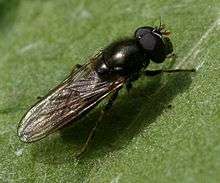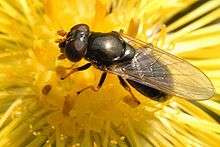Cheilosia pagana
| Cheilosia pagana | |
|---|---|
 | |
| male | |
 | |
| female | |
| Scientific classification | |
| Kingdom: | Animalia |
| Phylum: | Arthropoda |
| Class: | Insecta |
| Order: | Diptera |
| Family: | Syrphidae |
| Genus: | Cheilosia |
| Species: | C. pagana |
| Binomial name | |
| Cheilosia pagana (Meigen, 1822) | |
| Synonyms | |
Cheilosia pagana is a Holarctic species of hoverfly. Like most Cheilosia it is black, and because of this may often be overlooked as a hoverfly.[1] One identifying feature is a large red to orange 3rd antennal segment.[2]
Description
External images
For terms see Morphology of Diptera
Wing length 4.75-8·5 mm.Antennae with third segment clear orange and very large:no furrow. Frons flat in male.Thoracic pubescence variable.Female scutellum entirely black.Legs part yellow.Tarsi 1 with pale central segments pale.Part of the pagana species group.[3] [4] [5]
Distribution
Present in most of Europe and in the East Palearctic ecozone. [6] East to Siberia.[7] Nearctic [8]
Biology
Habitat: coniferous and deciduous woodland, unimproved grassland, along hedgerows in farmland and at roadsides.Scrub and carr.[9] Flowers visited include yellow composites, Ranunculaceae, white umbellifers, Allium ursinum, Anemone nemorosa, Fragaria, Potentilla erecta, Primula, Prunus spinosa and Salix.[10] Flight period is from May to September. In southern Europe, on the wing from mid March. Larvae are known to inhabit semi-liquid, decaying tissue of the roots of plants. There is a rearing record from decaying roots of Cow Parsley.[1]
References
- 1 2 Stubbs, Alan E.; Falk, Steven J. (1983). British Hoverflies: An Illustrated Identification Guide. British Entomological & Natural History Society. pp. 253, xvpp.
- ↑ Van Veen, M.P. (2004). Hoverflies of Northwest Europe, Identification Keys to the Syrphidae (hardback). Utrecht: KNNV Publishing. p. 254. ISBN 90-5011-199-8.
- ↑ Van der Goot,V.S. (1981) De zweefvliegen van Noordwest - Europa en Europees Rusland, in het bijzonder van de Benelux. KNNV, Uitgave no.32: 275pp. Amsterdam.
- ↑ Bei-Bienko, G.Y. & Steyskal, G.C. (1988) Keys to the Insects of the European Part of the USSR, Volume V: Diptera and Siphonaptera, Part I. Amerind Publishing Co., New Delhi. ISBN 81-205-0080-6.
- ↑ Coe, R.L. (1953) Diptera: Syrphidae. Handbks.ident.Br.insects, 10(1): 1-98. R.ent.Soc.London. pdf
- ↑ Fauna europaea
- ↑ Peck, L.V. (1988) Syrphidae. In: Soos, A. & Papp, L. (eds.) Catalogue of Palaearctic Diptera, 8: 11-230. Akad.Kiado, Budapest.
- ↑ Nearctic Syrphidae Checklist
- ↑ Speight, M.C.D. (2011). "Species accounts of European Syrphidae (Diptera)" (PDF). Syrph the Net, the database of European Syrphidae. 65: 285pp.
- ↑ de Buck, N. (1990) Bloembezoek en bestuivingsecologie van Zweefvliegen (Diptera, Syrphidae) in het bijzonder voor België. Doc.Trav. IRSNB, no.60, 1-167.